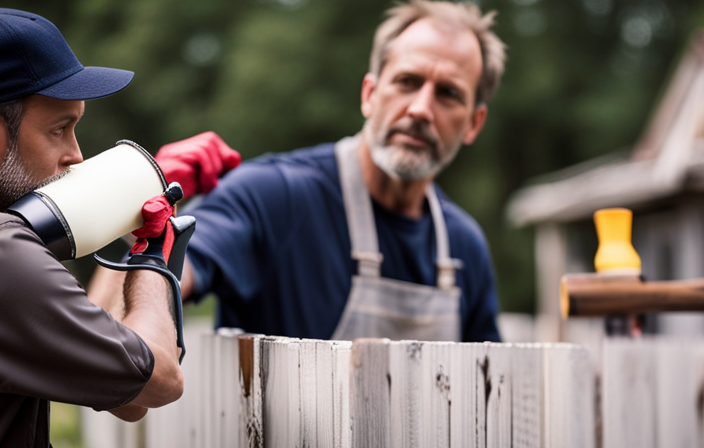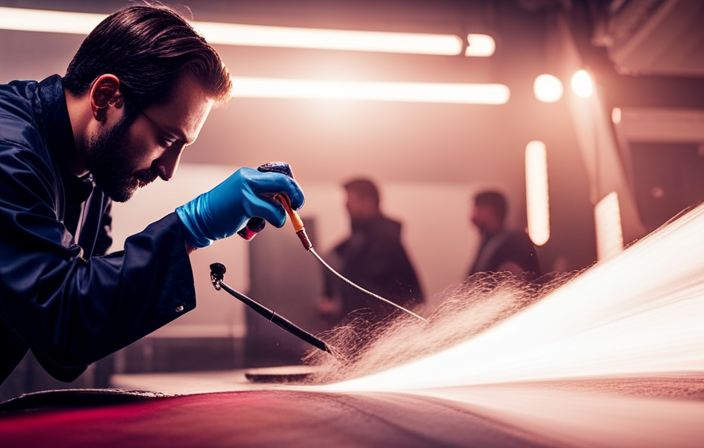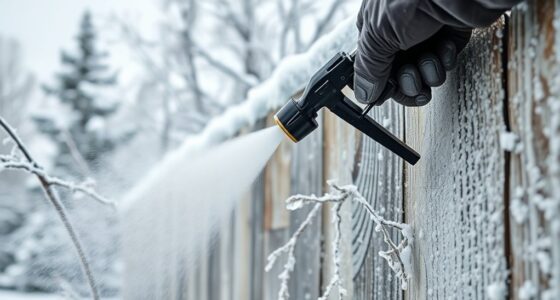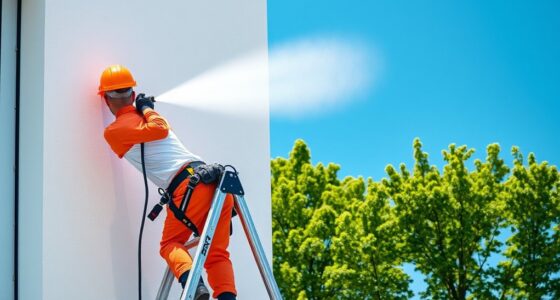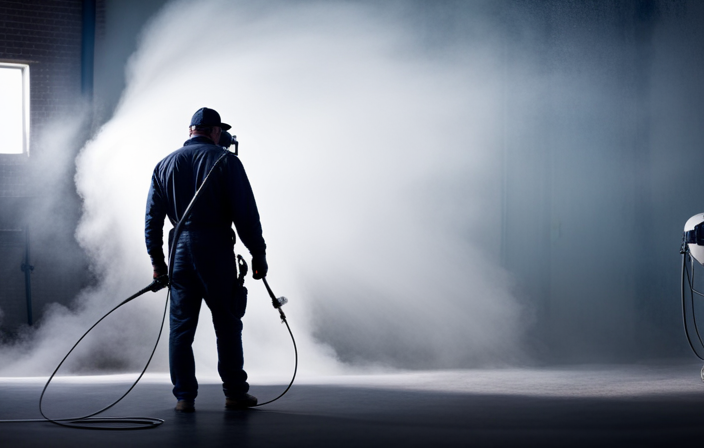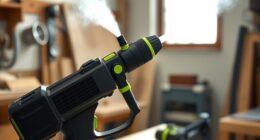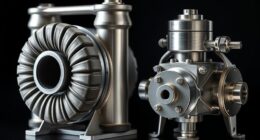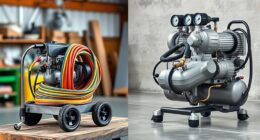Painting a house with an airless sprayer can be daunting, especially when it comes to choosing the right nozzles for different types of paint. But fear not, dear decorators! In this article, I will share my expertise and guidance on selecting the perfect nozzles for different paints to achieve a flawless finish.
Understanding the characteristics of different types of paint is crucial in selecting the right tip size. Whether you’re dealing with smooth surfaces that require a fine finish or rough surfaces that need a wide fan tip, I’ve got you covered.
I’ll also teach you how to adjust the pressure for different paints and demonstrate proper spray techniques.
But that’s not all! I’ll also provide insights on using painting shields or masking tape, as well as tips for cleaning and maintaining your sprayer.
Safety precautions are of utmost importance, and I’ll make sure to address those as well.
So, prepare your airless sprayer, get your paint ready, and let’s dive into the world of spray painting with confidence and expertise!
Key Takeaways
- Understand the characteristics of different paint types and choose the right one for your project
- Select the appropriate tip size based on the paint type and thickness
- Apply multiple thin coats for professional results and minimize overspray
- Use high-quality paint designed for airless sprayers for better performance
Understanding Different Types of Paint
When you’re spray painting a house with an airless sprayer, it’s important to understand the different types of paint and how they can enhance the look and durability of your home.
Different paint finishes serve different purposes and can bring out the best in your exterior surfaces. For example, flat paint works well to hide imperfections, while satin and semi-gloss finishes offer better resistance to moisture and are easier to clean.
Understanding the characteristics, benefits, and limitations of each paint type will help you make an informed decision when choosing the best paint for your project.
Now that you have a good understanding of the different paint finishes, let’s move on to the next step: choosing the right tip size for your airless sprayer.
Choosing the Right Tip Size
To get the best results, it’s crucial to pick the perfect tip size for your airless sprayer when tackling a paint job. The right tip size will ensure that the paint is applied evenly and efficiently.
When choosing the tip size, consider the type of paint you’re using and the surface you’re painting. For latex paints, a tip size of 0.015 to 0.019 inches is recommended. Oil-based paints work well with a tip size of 0.017 to 0.021 inches. If you’re using thicker coatings like elastomeric or textured paints, go for a larger tip size, around 0.025 inches.
Remember to also consider the paint color. Lighter colors may require a smaller tip size to avoid overspray, while darker colors can benefit from a larger tip size for better coverage.
Now, let’s move on to using a fine finish tip for smooth surfaces.
Using a Fine Finish Tip for Smooth Surfaces
When looking to achieve a professional look on smooth surfaces, it’s essential to use a fine finish tip with an airless sprayer. This tip allows for a more controlled application, resulting in a smoother and more even finish.
Additionally, using a fine finish tip helps minimize overspray, reducing the risk of paint ending up where it shouldn’t be. It also ensures even coverage, preventing any unsightly streaks or uneven areas on the surface.
As a professional painter, I know the importance of these key points and always recommend using a fine finish tip for achieving a flawless and professional result.
Achieve a Professional Look
For a flawless finish, imagine your house transformed with a professional touch when using an airless sprayer. To achieve a professional look, follow these tips:
-
Use a high-quality paint: Opt for a paint specifically designed for airless sprayers. These paints are formulated to provide a smooth and even finish, minimizing the chances of paint drips.
-
Choose the right tip size: The size of the tip you’re using will depend on the type of paint you’re using and the surface you’re painting. Consult the paint manufacturer’s recommendations for the correct tip size.
-
Maintain proper technique: Hold the sprayer at a consistent distance from the surface and move your arm smoothly in a controlled manner. This helps to avoid uneven application and streaks.
-
Apply multiple thin coats: Instead of trying to cover the surface in one thick coat, apply several thin coats. This will result in a more professional and even finish.
By following these tips, you can achieve a flawless finish while minimizing the chances of paint drips. To further enhance your results, the next step is to minimize overspray.
Minimize Overspray
Achieving a flawless finish with an airless sprayer won’t just transform your home, but it’ll also leave you with a professional look that’ll make you feel like a painting expert.
When using an airless sprayer, it’s important to minimize overspray to avoid paint buildup and reduce paint wastage. To do this, start by adjusting the spray pressure on your sprayer. Lower pressure settings will help control the amount of paint being sprayed, resulting in less overspray.
Additionally, use a technique called ‘feathering’ to blend each stroke smoothly and prevent heavy buildup in certain areas. By moving your hand in a sweeping motion while painting, you can create an even, thin layer of paint. This will ensure even coverage and a flawless finish.
Transitioning into the next section, let’s discuss how to achieve perfect coverage with an airless sprayer.
Ensure Even Coverage
To ensure a smooth and flawless finish, make sure you evenly cover every surface with your airless sprayer, creating a seamless and professional look. Achieving even coverage is essential for a uniform appearance and to avoid streaks.
When using an airless sprayer, it’s important to maintain a consistent distance from the surface being painted. This ensures that the paint is applied evenly and prevents any areas from being overlapped or missed. Additionally, consider using a technique called ‘back brushing’ to help spread the paint evenly and eliminate any excess build-up. This involves using a brush to lightly smooth out the paint after spraying, ensuring a more even distribution.
By following these tips, you can achieve a flawless finish with your airless sprayer. Speaking of techniques, using a wide fan tip for rough surfaces can further enhance your results.
Using a Wide Fan Tip for Rough Surfaces
When working on rough surfaces, using a wide fan tip with an airless sprayer offers several advantages.
Firstly, it allows me to cover large areas quickly, saving valuable time and effort.
Secondly, the wide fan pattern helps the paint to penetrate deep into the textured surfaces, ensuring even coverage.
Lastly, this tip helps to prevent clogging and drips, resulting in a smoother and more professional finish.
As an experienced painter, I’ve found that using a wide fan tip is the most efficient and effective method for painting rough surfaces with an airless sprayer.
Cover Large Areas Quickly
For lightning-fast coverage, whip out an airless sprayer and watch as your large areas become a canvas for transformation. To cover large areas quickly, it’s important to choose the right tip size for your airless sprayer. This will depend on the type of paint you’re using and the texture of the surface you’re painting. Here’s a helpful table to guide you:
| Paint Type | Tip Size | Recommended Use |
|---|---|---|
| Latex | 0.015-0.017 inches | Smooth surfaces |
| Oil-based | 0.017-0.021 inches | Smooth or textured surfaces |
| Acrylic | 0.015-0.017 inches | Smooth or textured surfaces |
By selecting the appropriate tip size, you can achieve efficient and even coverage, reducing paint waste and saving you time and money. Now, let’s move on to the next section where we’ll explore how to penetrate deep into textured surfaces.
Penetrate Deep into Textured Surfaces
To achieve even coverage on deep textured surfaces when spray painting a house with an airless sprayer, it’s important to follow specific tips for each type of paint.
-
For textured surfaces, such as stucco or brick, use a paint with a thicker consistency. This will help the paint penetrate deep into the crevices and provide a more uniform finish.
-
Consider using elastomeric paint, which is designed to stretch and contract with the surface, preventing cracking or peeling.
-
Another option is to apply a high-build primer. This fills in the texture and creates a smooth base for the top coat.
-
Additionally, adjust the spray nozzle to a wider fan pattern. This will help ensure that the paint reaches all areas of the textured surface.
By following these tips, you can achieve a professional-looking finish on deep textured surfaces.
Now, let’s move on to the next section about preventing clogging and drips.
Prevent Clogging and Drips
Prevent clogging and drips by mastering the art of controlling the flow and consistency of your paint. When using an airless sprayer, it’s important to choose the right tip size for the type of paint you’re using.
For thicker paints, such as elastomeric or textured coatings, a larger tip size like a 0.021 or 0.023 is recommended. This will help prevent paint buildup and ensure a smooth application.
Additionally, regularly inspect and clean the filter and tip to prevent clogs. If you encounter any issues with clogging or drips, try adjusting the pressure or thinning the paint slightly to improve flow.
Troubleshooting common issues like these will help you achieve professional results. Speaking of adjusting the pressure for different paints…
Adjusting the Pressure for Different Paints
When it comes to adjusting the pressure for different paints, it’s important to understand that thick paints require high pressure while thin paints need low pressure. Finding the right balance between the two is crucial for achieving optimal results.
As a professional painter, I’ve learned that high pressure helps thick paints atomize properly and provides better coverage, while low pressure prevents overspray and allows for a smoother finish with thin paints.
By understanding the characteristics of different paints and adjusting the pressure accordingly, you can ensure a successful paint job.
High Pressure for Thick Paints
If you’re using thick paints, crank up that pressure on your airless sprayer for a smooth and even application! Here are some tips to help you achieve the best results:
-
Use a larger tip size: Thick paints require larger tip sizes to allow for better atomization and flow. This helps prevent clogging and ensures an even coat.
-
Increase the pressure gradually: Start with a lower pressure setting and gradually increase it until you achieve the desired spray pattern and coverage. This will help you avoid overspray and ensure a smooth finish.
-
Maintain a consistent distance: Keep a consistent distance between the sprayer and the surface being painted. This will ensure an even application and prevent uneven coverage.
-
Watch for drips and runs: Thick paints are more prone to dripping and running. Take your time and apply multiple thin coats instead of one thick coat to minimize these issues.
By following these tips, you can effectively use your airless sprayer with thick paints. Speaking of thin paints, let’s now discuss how to adjust the pressure for achieving smooth finishes with them.
Low Pressure for Thin Paints
To achieve those smooth finishes with thin paints, go ahead and give that pressure a little low-key love.
When it comes to spraying thin paints with an airless sprayer, it’s important to lower the pressure to ensure a professional finish. Thin paints, such as lacquers or stains, require a lower pressure setting to avoid overspray and achieve even coverage. By adjusting the pressure on your airless sprayer, you can control the flow of the paint and prevent it from misting or splattering.
Start by testing the paint on a scrap surface to find the right balance between too much and too little pressure. This will help you achieve that perfect application and ensure a flawless outcome.
So, let’s find that sweet spot and move on to the next step of finding the right balance.
Finding the Right Balance
Achieving a flawless outcome requires finding the perfect balance between pressure and paint application. When using an airless sprayer, it’s crucial to find the right pressure that allows for smooth and even coverage. Here are some tips to help you find the right balance:
- Experiment with different pressure settings to determine the ideal one for your specific paint type.
- Start with a lower pressure and gradually increase it until you achieve the desired results.
- Consider the viscosity of the paint and adjust the pressure accordingly. Thicker paints may require higher pressure settings.
- Pay attention to the spray pattern. If it appears uneven or blotchy, you may need to adjust the pressure or the nozzle size.
- Regularly check the pressure gauge during the painting process to ensure it remains consistent.
Choosing the right paint type is equally important. Different paints have different characteristics, benefits, and limitations. Understanding these factors will help you make an informed decision and achieve a professional finish.
Now, let’s move on to the next step and discuss the importance of preparing the surface properly.
Preparing the Surface Properly
When preparing the surface for painting, it’s important to clean and remove any loose paint. This ensures that the new paint will adhere properly and create a smooth finish.
Additionally, it’s crucial to repair any cracks and holes in the surface to ensure a uniform appearance.
Lastly, if needed, using a primer can help to create a strong bond between the surface and the paint, resulting in a longer-lasting finish.
As a professional painter, I understand the importance of properly preparing the surface before painting to achieve the best results.
Clean and Remove Loose Paint
Start by scraping away any loose paint with a sturdy putty knife, revealing a clean canvas ready for your fresh coat of paint. To ensure a smooth and long-lasting finish, it’s crucial to clean the surface thoroughly before applying paint. For this task, you’ll need some cleaning equipment such as a pressure washer or a scrub brush, along with a mild detergent. Begin by removing any dirt, grime, or mold from the walls using the pressure washer or scrub brush. Be careful not to damage the surface while cleaning. Once the walls are clean, protect the surrounding areas by covering them with plastic sheets or drop cloths. This will prevent overspray and ensure that your paint job is neat and precise. After cleaning and protecting, you can proceed to the next step of repairing any cracks and holes in the surface.
| Cleaning Equipment | Protecting Surrounding Areas |
|---|---|
| Pressure Washer | Plastic Sheets |
| Scrub Brush | Drop Cloths |
Now, let’s move on to repairing any cracks and holes in the surface.
Repair Cracks and Holes
To successfully repair cracks and holes in your walls, you’ll need to gather some essential tools such as a putty knife, spackling compound, sandpaper, and a primer. Here’s a step-by-step guide to help you with the surface preparation and filling compound:
-
Clean the area: Before filling the cracks and holes, make sure to clean the surface thoroughly to remove any dirt, dust, or loose paint. This will ensure better adhesion for the filling compound.
-
Apply the filling compound: Use a putty knife to apply the spackling compound into the cracks and holes. Make sure to fill them completely and level it with the surrounding surface. Allow it to dry according to the manufacturer’s instructions.
-
Sand the filled areas: Once the compound is dry, use sandpaper to smooth out the filled areas. This will create a seamless finish and prepare the surface for painting.
Remember, if there are larger cracks or holes, you may need to use a patching material instead of a filling compound.
Now that the cracks and holes are repaired, let’s move on to the next step: using primer if needed.
Use Primer if Needed
If you want to achieve a professional-looking finish on your walls, primer is an essential step that shouldn’t be overlooked. Using primer before spray painting with an airless sprayer helps to ensure that the paint adheres properly and provides a smooth and even coverage.
Before applying primer, it’s important to prepare the surface by cleaning it thoroughly and repairing any cracks or holes. Primer can be especially beneficial if you’re painting over a previously painted surface, as it helps to hide stains and imperfections. Additionally, primer creates a uniform surface for the paint, allowing it to adhere better and last longer.
By using primer and properly preparing the surface, you can achieve a flawless paint job that’ll enhance the overall appearance of your house.
Now, let’s move on to the next step: practicing proper spray technique.
Practicing Proper Spray Technique
When practicing proper spray technique with an airless sprayer, I always maintain a consistent distance from the surface being painted. This helps to ensure an even application of paint and prevents any potential drips or uneven coverage.
I also move in smooth and even strokes, being careful not to linger in one area for too long. Lastly, I make sure to overlap each pass slightly to avoid any visible lines or streaks in the finished paint job.
These techniques, honed through years of experience, result in a professional and flawless finish.
Maintain a Consistent Distance
Maintaining a consistent distance while spray painting with an airless sprayer is like dancing with the paint, ensuring a smooth and even application. To achieve this, it’s important to maintain a steady distance between the spray gun and the surface being painted.
This distance typically ranges from 12 to 18 inches, but it may vary depending on the type of paint being used. Adjusting the spray pattern on the gun can also help maintain consistency. By rotating the nozzle or adjusting the fan width, you can create a more focused or wider spray pattern, allowing for better coverage and control.
Professionals in the painting industry understand the importance of clear communication. They provide detailed instructions on how to maintain the spray gun and adjust the spray pattern for different paint types, ensuring a thorough understanding of the topic.
Moving in smooth, even strokes is the next step in achieving a professional finish.
Move in Smooth, Even Strokes
Achieving a flawless finish requires moving the spray gun in smooth, even strokes, ensuring a seamless application of paint. This technique is crucial for avoiding streaks and achieving a professional-looking result.
To achieve a smooth application, it’s important to maintain a consistent distance from the surface being painted. This distance will vary depending on the type of paint being used, so it’s essential to refer to the manufacturer’s guidelines for specific recommendations.
Additionally, it’s important to move the spray gun at a steady pace, neither too fast nor too slow. This will help to distribute the paint evenly and prevent buildup in certain areas.
By moving in smooth, even strokes, you can achieve a beautiful, streak-free finish on your house.
Transitioning into the next section, it’s also important to overlap each pass to ensure complete coverage.
Overlap Each Pass
To create a flawless finish that will impress even the most discerning eye, it’s crucial to carefully overlap each pass of the spray gun. By doing so, you ensure that every inch of the surface receives an even coat of paint, achieving seamless coverage and avoiding streaks and lines.
When using an airless sprayer, it’s important to maintain a consistent speed and distance as you move the gun across the surface. Start each pass slightly overlapping the previous one, about 50% to 75%. This ensures that there are no missed spots and that the paint is evenly distributed. Take your time and be mindful of any corners or edges that may require extra attention.
By overlapping each pass, you’ll achieve a professional-looking paint job with no visible lines or uneven areas.
Speaking of attention to detail, the next section will explore how using a painting shield or masking tape can further enhance the quality of your work.
Using a Painting Shield or Masking Tape
For a flawless finish, make sure to use a painting shield or masking tape to protect areas you don’t want to be painted. A painting shield is a handy tool that can be held or attached to a spray gun to create a barrier between the paint and the surrounding surfaces. It helps prevent overspray and ensures clean, crisp edges. Masking tape, on the other hand, is ideal for protecting smaller areas or intricate details. Apply it carefully along the edges of windows, trim, or any other surfaces you want to keep paint-free. Remember to remove the masking tape promptly after painting to avoid any peeling or damage to the fresh paint. Now that you’ve protected the areas you don’t want to paint, let’s move on to the next step of cleaning and maintaining the sprayer.
Cleaning and Maintaining the Sprayer
After you’ve finished transforming your space with a fresh coat of color, it’s crucial to ensure the longevity of your sprayer by properly cleaning and maintaining it.
Cleaning equipment is an essential part of this process. Start by thoroughly flushing the sprayer with water to remove any residual paint. Next, disassemble the spray gun and clean each part individually using a brush and solvent. Pay special attention to the nozzle and filters, as they’re prone to clogs.
Regularly inspect and replace any worn or damaged parts to avoid potential issues. Additionally, lubricate the moving parts of the sprayer to keep it running smoothly.
By following these cleaning and maintenance steps, you can prevent clogs and ensure the optimal performance of your airless sprayer.
Now, let’s move on to discussing important safety precautions to keep in mind during the spraying process.
Safety Precautions
Now that we’ve covered how to clean and maintain your airless sprayer, let’s talk about safety precautions when spray painting a house. Safety should always be a top priority when working with any type of paint, especially when using an airless sprayer.
One important aspect of safety is respiratory protection. Paint fumes can be harmful if inhaled, so it’s crucial to wear a respirator mask that’s specifically designed for painting.
Another safety consideration is the handling of hazardous materials. Some paints may contain toxic substances, so it’s important to read the product labels and follow the manufacturer’s instructions for safe handling and disposal.
Additionally, make sure to wear protective gloves and clothing to prevent any skin contact with the paint.
By taking these safety precautions, you can ensure a safe and successful spray painting project.
Frequently Asked Questions
Can I use the same tip size for all types of paint when using an airless sprayer?
No, it is not recommended to use the same tip size for all types of paint when using an airless sprayer. Adjusting pressure and using the appropriate tip size is important for optimal paint application and safety precautions.
How do I know if I need to adjust the pressure when using different types of paint?
To determine the optimal pressure for different types of paint, I assess their consistency and viscosity. If the paint is thicker, I increase the pressure; if it’s thinner, I decrease it. I troubleshoot issues by adjusting the pressure gradually until I achieve the desired results.
Are there any specific safety precautions I need to take when using an airless sprayer?
When using an airless sprayer, it’s important to take specific safety precautions. Some common mistakes to avoid include wearing protective clothing, using proper ventilation, and following the manufacturer’s instructions. Stay safe!
What is the best way to clean and maintain the sprayer after use?
To ensure optimal performance and longevity of your airless sprayer, follow these best maintenance practices. After each use, clean the sprayer thoroughly, inspect for any damage, and troubleshoot common issues like clogs or leaks.
Can I use a painting shield or masking tape with any type of paint?
Yes, you can use a painting shield or masking tape with different types of paint finishes. It helps achieve smooth and even coverage. Here are some tips for using them effectively with an airless sprayer.
Conclusion
In conclusion, when spray painting a house with an airless sprayer, it’s crucial to understand the different types of paint and choose the right tip size accordingly.
Using a fine finish tip for smooth surfaces and a wide fan tip for rough surfaces will ensure the best results.
Adjusting the pressure for different paints and practicing proper spray technique are also important.
Using a painting shield or masking tape can help protect surrounding areas.
Cleaning and maintaining the sprayer regularly will prolong its lifespan.
Remember to prioritize safety precautions throughout the process.
With these tips, you’ll be able to achieve a professional-looking paint job that’ll leave your house looking brand new, as if it were painted by a magical unicorn!
